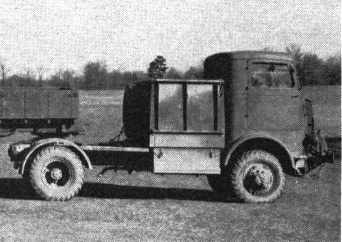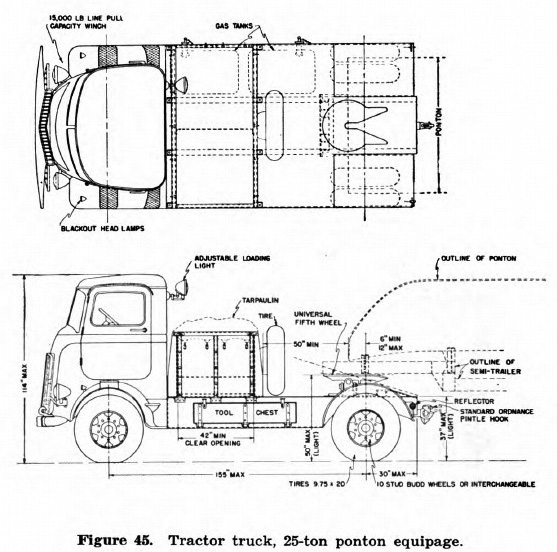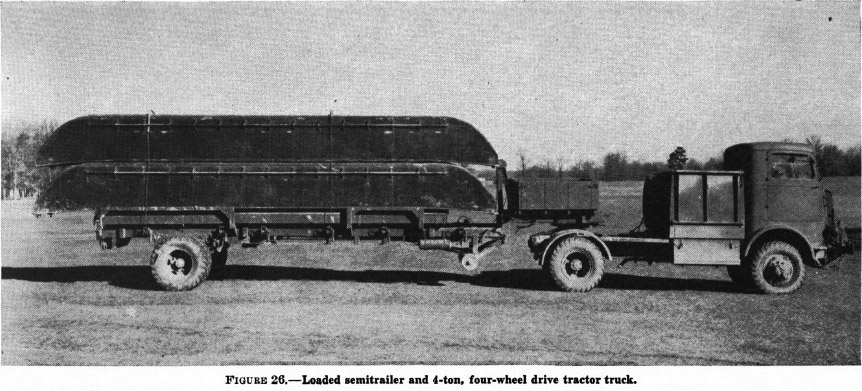Mack NJU 5-ton 4x4 truck (1941)
 USA (1941). 4x4 COE Tractor (700 built)
USA (1941). 4x4 COE Tractor (700 built)

The Mack NJU 5-6 ton 4x4 Pontoon tractor (G639) was a semi-tractor (meant for towing a trailer) designed to haul bridging equipment in World War II. The US obtained 700 built total, and from these, 119 were supplied to the British in Egypt, and 8 declined with van bodies, while the rest were used as a "substitute standard" by the US Army. Better known and very close in design were the Autocar U8144T. Both were indeed COE or "cab over engine" tractors, but unlike the Autocar, which production was far more substantial, the Mack tractors only existed as enclosed cab versions.

Mack Trucks for the US Army
During World War II, Mack Trucks continued to supply a variety of military vehicles, including heavy-duty trucks and specialized vehicles for combat and logistical purposes. The Mack NO series was used extensively, and the company produced more than 60,000 trucks for military service during the war. Mack also produced specialized vehicles like fuel tankers, troop carriers, and recovery vehicles for the Army during WWII.
Design
 NJU technical overview, wikimedia cc
NJU technical overview, wikimedia cc
In 1940, the US Army ordered 700 Mack 4x4 truck tractors, intended as tractor for towing trailers adapted for carrying each tow pontoon on standard semi-trailers, the same type as used by the Autocar U8144T. In total, some 694 were delivered in 1941, the last 6 in 1942. It was basically the Autocar design standardized by the US Army which plans were passed on to, and adapted by Mack, and this repreented only a small fraction of its production. In fact only "700 NJUs" were built.
The design was a militarized version of a civilian Mack Cab Over Engine (COE) model and it was redesigned as a 4WD, using patterns from Autocar. The EN532 engine was a 532 cu in (8.7 L) L-head inline 6 cylinder gasoline which developed 136 hp (101 kW) at 2500 rpm and was coipled with a 5-speed transmission with Timken 2-speed transfer case and double-reduction axles, driving the separate transfer case.
The chassis had a ladder frame with two live beam axles on leaf springs. The wheelbase was 155 inches (3.94 m). The forward bumper was holding a winch rated for 15,000 pounds (6,800 kg) with a pintle hitch at the rear. The civilian type closed cab was reused with some simplifications inside. Behind the cab was located the standard open cargo box carrying engineer tools as well as outboard motors and other equipment, same model and standard as the Autocar model. The early semi-tractors and vans had 9.75x20 tires. Later semi-tractors used 12.00x20 tires. The rear axles had dual rear tires and full-air brakes are standard.
The 700 cabover tractors NJU1 4x4 with the EN532 engine (8,7l, 136 hp) with 10-speed transmission and pneumatic brakes were used for towing the pontoon elements. The cabin was the commercial model series C. Aside the driver there was bench large enough for two men. The Mack NJU was not armed nor armoured. The crew had its personal weapons for close defense, notably the M1 Carbine and M1911 revolvers.
Variants
Mack NJU1: Pontoon elements carrier trailer. Some used by British troops in Egypt. 700 units produced.
Mack NJU2: Without cargo box behind the cab. For semi trailers of Topographic Service, 8 made.
The Mack NJU-1 Ponton Tractor, 5-ton, 4x4 (G-639) was specialized for towing ponton trailers loaded with bridge sections. Its wheelbase was 148 inches, width 96 in. and length 237 in, height 114 in. Maximum towered load 30,000 lbs. The box behind the cab for stowage was related to bridge erection duties. The vehicle was generally very similar Autocar U-8144-T Pontoon Tractor.
Mack NJU-1 specifications |
| Dimensions (L-w-h) | 237 x 96 x 114 in (6 x 2.4 x 2.9 m) |
| Wheelbase | 148 in (3.75 m) |
| Curb weight | 7,525 ton, max load traier 30t |
| Crew | 1 driver+2 |
| Propulsion | Mack EN 532 6 cyl. 136 hp, 532 cu. in. |
| Transmission | Timken 10 speeds |
| Top speed | c50 kph unladen |
| Max range | Cons. 78,5 L aux 100km, c400km |
Le Mack NJU in service
 The NJU-1 tractor complete with its ponton trailer
The NJU-1 tractor complete with its ponton trailer
Apart the 692 NJU-1 tractors there were eight NJU-2 vans, very specific vehicles designed to tow topographical trailers, one for every division.
In November 1941, it was agreed between both government to provided 119 semi-tractors to the British army in Egypt, and the War Department gave them H-numbers. Some NJU-1's also were given to the French Army service post war, used to maintain lined of communications or for their original pontoon role.
In the latter role, the NJUs carried the standard US Army rigid pontons. The spelling "ponton" came from the old French, from Latin ponto ("ferryboat"), and pons ("bridge"). First use in English went back to 1870. Called that way in U.S. patents of the 1890s but in World War II, "ponton" was used for the bridge itself, "pontoon" for the floats.
In any case, they were vital to allied engineers in order to replaced blown bridges across rivers. The most famous example in the European campaign was the late 1944 crossing of the Rhine and Moselle. US Army engineers provided either the M1938 infantry footbridges, M1938 ponton bridges, and M1940 treadway bridges. The pontons were fitted with a deck built of balk, and reinforced by rather square, hollow aluminum beams. They were not usable as utility boats, although they could be modified as such. But they were not open top as when a 30+ tonnes rolled over the bridge, they submerged well over their freeboard level. An Engineer Treadway Bridge Company was capable of creating a 540 feet (160 m) long floating bridge, using maps and recce to find the best (shortest) crossing point. The M1 pontons were 29 feet 7 inches (9.02 m) long overall, 6 feet 11 inches (2.11 m) wide at the gunwales, and 3 feet 4 inches (1.02 m) deep.